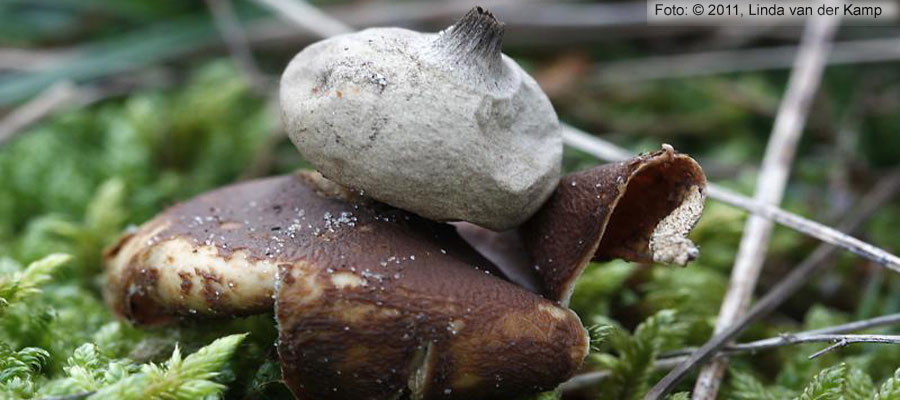
Photo: Felty Earthstar (AWD), Linda van der Kamp |
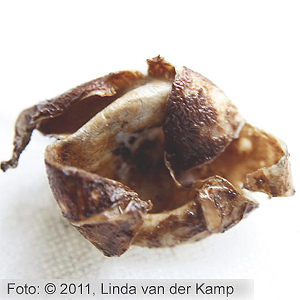
Photo: bottom dried Felty Earthstar |
Felty Earthstar
(Geastrum saccatum)
NMV Ga 211120
This website's primary concern is the Amsterdam Area, incl. the pleistocene area
(Het Gooi) and parts of the Northsea dunal coast. |
Felty Earthstar
is a smal to medium sized earthstar, without stem, with a fibriate mouth-zone, with court and often with a clear ring-furrow.
Older and more mature Felty Earthstars have a brown-yellow color, a felty pale star-rays-bottom, and enrusted debris, but no scar.
Sometimes old Felty Earthstars look like Collared Earthstars with wobble-tiptoes and a pale dirty white layer when the felty layer is worn.
Field-marks to distinct older Felty Earthstar from older Collared Earthstar:
- Felty Earthstar has a felty layer at the bottom of its star-rays, heeft een kale onderkant.
- Felty Earthstar maakt vaak een kraag, maar deze is veel onduidelijker dan bij de Collared Earthstar
- Felty Earthstar De slippenkrans is omgekruld (=saccaat), maar bij oude exemplaren draaien de slippunten vaak terug, naar een uitgespreide stand (=pseudoconvex).
Bij een Collared Earthstar staat de slippenkrans meestal vrijwel uitgespreid(=convex), zelden omgekruld(=saccaat).
De slippunten bewegen op oudere leeftijd niet alsnog een andere kant op dan de rest van de slip.
|
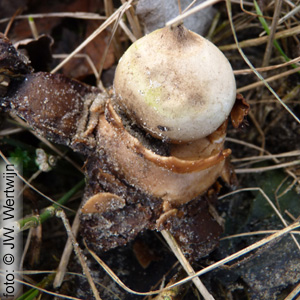
Collar, tubal, wobble-toes:
Photo: Felty Earthstar, January 7 2012
pseudo-convex star-rays |
Mistakability (young):
Mistakability (mature):
|
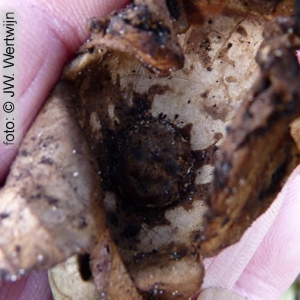
Photo:bottom Felty Earthstar,
felty and with curling-wobblish tiptoes
Meijendel, January 7 2012 |
| |
Felty Earthstar
(Geastrum saccatum) |
Flask Earthstar
(Geastrum lageniforme) |
Collared Earthstar
(Geastrum triplex) |
Sessile Earthstar
(Geastrum fimbriatum) |
| star-rays |
curled (saccate), older curling tiptoes |
curled (saccate), long, small ray-tips |
often spread (convex), sometimes curled (saccate) |
curled (saccate) |
| bottom star-rays |
felty |
thin, bald |
thick, bald |
white (below encrusted debris) |
| encrusted debris |
no |
no |
no |
yes |
| with a scar |
yes (2-4 mm) |
yes |
yes |
no |
balloon
(mouth-zone) |
fibrillose,
often with court and ring-furrow |
fibrillose,
often with court and ring-furrow |
fibrillose,
with court, sometimes without ring-furrow |
fibrillose,
without court, without ring-furrow |
| with collar |
sometimes |
never |
often |
never |
How to exclude mistakability:
- Balloon description (mouth-zone, surface, color)
- Star-rays description (curling, wobbletoes, color, thickness)
- Earthstar upside down:
- Earthstar fixed to the ground (Encrusted debris)
- Bottom color of the star-rays (pale-white or felty)
- Check for a scar
- If this is not helpful: dry the earthstar, and see what changes during the dry-process
|
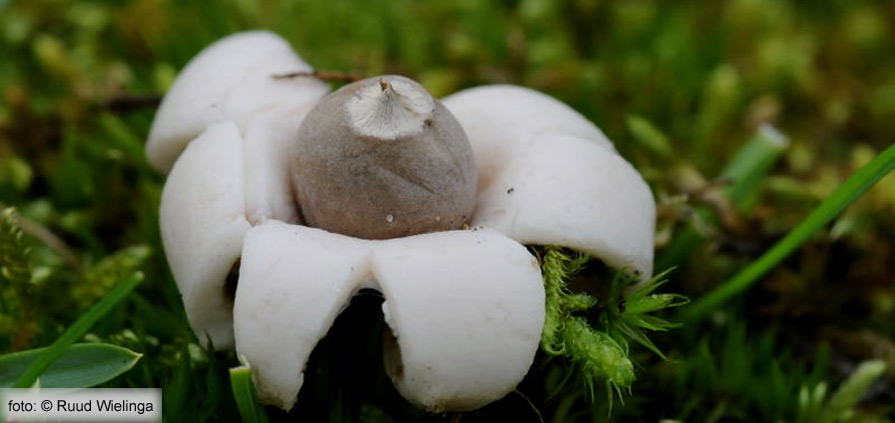
Photo: Felty Earthstar (Geastrum saccatum) Meijendel (De Loopert), October 29 2010 |
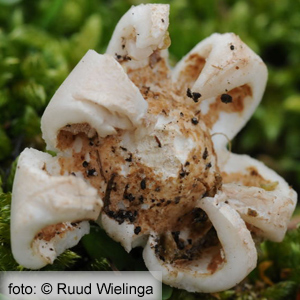
Photo: Felty Earthstar (bottom) |
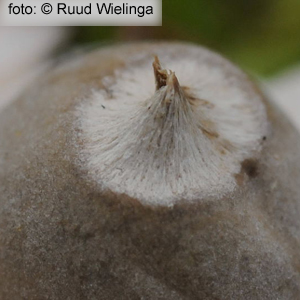 |
These pictures illustrate the mistakability at yough.
Sessile Earthstar (Geastrum fimbriatum).
Elegant Earthstar (Geastrum elegans)
and Flask Earthstar (Geastrum lageniforme)
start bright-white, with a small white, creme or grey balloon of 6-24 mm in diameter.
The star-rays curling very soon (=saccate), and elevate the balloon a bit.
Balloon color (white, grey), Mouth-zone (with/without court), saccate star-rays, are species specific. |
|
Habitat:
Felty Earthstar prefers calcareous on open and poorly vegetated dunes.
This means mossy vegetations at dry, humous-poor sandy soil, in dunal grasslands, often near little bushes.
Felty Earthstar can be found in relative pioneer vegetations, and in sand-drifted open wood.
Standing-place (older earthstars):
The stand in Meijendel of older collared Felty Eathstars is an east-west dunal hill, with a concave at the north.
In that concave there is a Hawthorn wood of about 15 meter length.
Halfway, between the Hawthorns there were at least 12 Felty earthstars at January 7 2012.
The soil was poorly bad wssted litter of Hawthorn leaves, and it was poorly vegetated by glechoma hederacea and some grass.
A bit higher at the slope, more sandy, less vegetation, there were more earthstars, smaller, more compact.
The lower ones were bigger in size of the ballons and of the star-rays.
First impression:
The first idea was Collared Earthstar, but with something strange (tubal shape wih wobble-toes)
Perhaps a dunal shape? Turning the earhstar upside-down, it became clear.
White, pale felty bottom, exit idea Collared Dune Earthstar. This must be Felty Earthstar. |
|
Wood species: not specific, the function of a tree for Felty Earthstar is shadow and protection against the wind.
Deciduous wood (Ash, Black Elder, Common Dwarf Willow, Common Spindle Tree, Elm, Hawthorn)
|
Regional:
Urban Amsterdam Area: no
Pleistocene Area: no
Northsea Dunal Area: yes
|
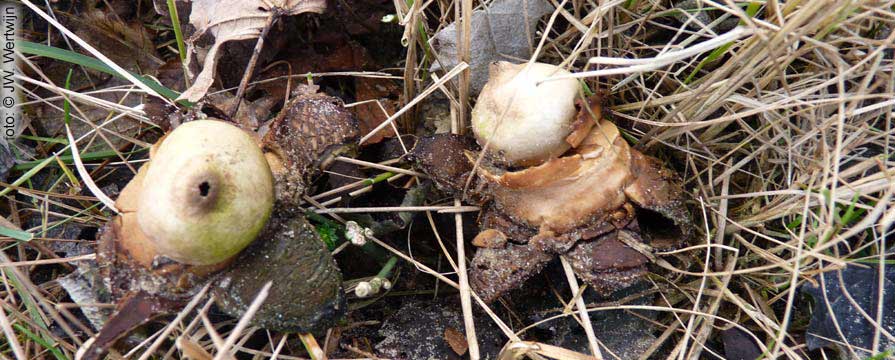
Photo:Felty Earthstar (Geastrum saccatum), Meijendel, January 7 2012 |
|
Field-marks: See: Anatomy Genus Geastrum
Felty Earthstar field-marks:
- Species size: small to medium
- Stem: No
- Balloon size: 0,7 tot 2,0 cm
- Balloon surface: bald
- Balloon color: beige to light grey-brown
- Balloon mouth-zone: fibrillose, with court, often with ring-furrow
- Star-rays number: 5-8
- Star-rays-thickness: to 3mm
- Star-rays surface: thick meaty surface, first white later brown, at drying sometimes collar-forming
- Star-rays color young: white to beige
- Star-rays color older: brown
- Star-rays: old star-ray-tips can curl only once up or down.
- Star-rays: non-hygroscopic (non-repetitive curling and stretching)
- Star-rays: 1 - 4,5 cm in diameter
- Star-rays: saccate (curled)
- Star-rays bottom color: ochre to light brown-yellow felty layer
- Star-rays-scar: yes 2-4 mm in diameter
- Star-rays-encrusted-debris: no
|
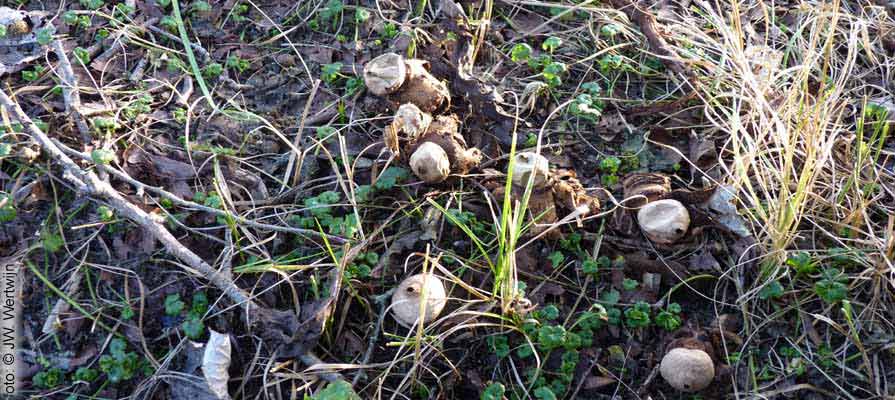
Photo:Felty Earthstar (Geastrum saccatum), Meijendel, January 7 2012 |
Literature:
Chrispijn, R. ed. (1999), Champignons in de Jordaan (De paddenstoelen van Amsterdam), Schuyt en Co, 162-163.
Hansen L. & H. Knudsen (1997), Nordic Macromycetes, Vol. 3, Heterobasidioid, aphyllophoroid and gasteromycetoid basidiomycetes, Kopenhagen, 1997, 444 pp.
Jalink, Leo M (1995) De aardsterren van Nederland en België, Coolia 38 Supplement.
www.mycobank.com
|
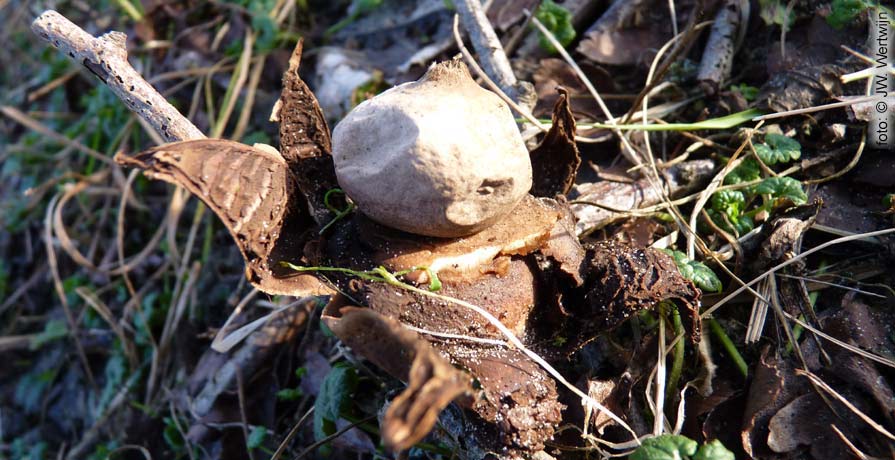
Foto:Viltige aardster (Geastrum saccatum), Meijendel, 7 jan. 2012 |
Top
|